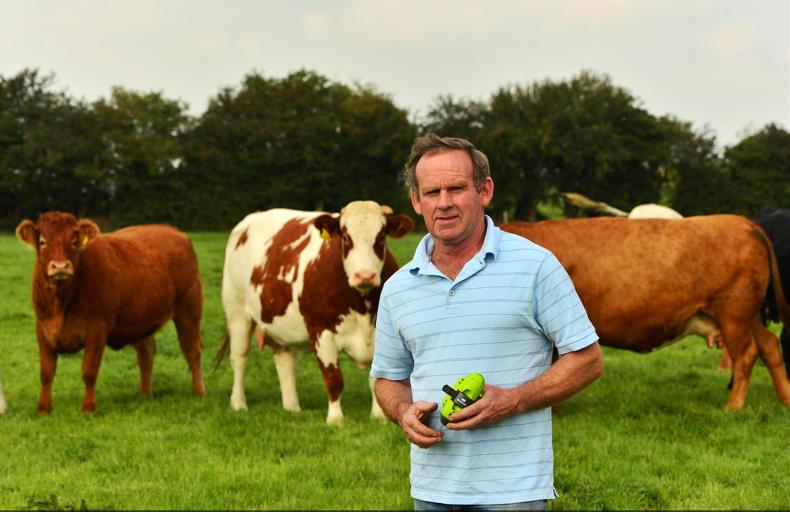Despite all the new technologies that are emerging, the one area that is still lacking is around basic health and safety.
According to a recent ERSI report, the agricultural, fishing and forestry sector in Ireland has the highest rate of fatal injuries across sectors. The rate is 10 times higher than the overall rate. You would think with these statistics there would be an open goal for companies looking to develop products for the area.
Despite all the talk of safety and the risk on farms, there are few products that are commercially available at a price that farmers will consider buying them. A trawl of the web brings up very few safety devices in the agtech space. The ones that are available are mainly slurry gas sensors, but in most cases farmers do not think they will need them enough to actually buy one.
In fairness, new machines do all come with safety features. It is how well they stand up to the extreme environments on the farm that dictate if they are there when they are really needed. Education of farmers is seen as a key area and cannot be focused on often enough. The ERSI report highlights the different behavioural culture on small and larger farms. In many cases not getting help with the difficult jobs was one of the main reasons for near misses.
There is no shortage of ideas to reduce accidents on farms. Our own Safe Family Farms schools competition with ESB Networks is a case in point. Over the years I have seen a range of ideas being developed. One I was specifically interested in was where work zones were created on the farm.
The smartphone is used to measure farmer’s activity. If the phone remained in one place for too long, it would send an alert to someone else’s phones. The thinking was that where the phone remains static, the farmer could have had an accident.
I never saw it come to market. The challenge is the large cost of developing and the business model of bringing these ideas to market. You can’t put a price on a lost life or limb. However, you have to be able to market the safety device at an affordable rate and then get enough farmers realising that an accident could happen to them so they should buy them.
Hazel Williams, TSSG, Waterford Institute of Technology, has been pushing the role of technology to improve safety on Irish farms for a number of years now. She agrees that there is very little out there at the moment.
“In some cases farmers buy technologies that have a secondary safety aspect to them,” said Hazel. One such example she gave was Moocall, the device that alerts a farmer when a cow is calving. “If a farmer who uses this can get a good night’s sleep they are less likely to make a mistake the following day due to sleep deprivation,” she said.
Hazel said TSSG has built technologies that could easily be transferred and adapted to health and safety on farms. One such technology is a device that can be put on a child’s clothing that will alert all the adults on the farm if the child goes out to the farmyard.
“It is even advanced enough that a contractor who drives onto the farm can be alerted to that fact that there is a child on the farm, she said. This technology was developed for an urban environment through an EU Project called ‘Societies’ but can be adapted into this sector. At the Irish Farmers Journal AgTech conference in January, Intel’s Charlie Sheridan said sensors are becoming cheaper, allowing them to be used throughout the farm.
UCD has also developed farm trackers that will set off an alert in the tractor cab if someone gets too close.
There is no shortage of expertise across the country. “We need to link together the different Research Centres such as TSSG, Nimbus, Tyndall etc and public bodies like Teagasc and Enterprise Ireland etc who are all experts in a specific areas,” said Hazel.
TSSG is involved in bringing together a stakeholder meeting of up to 15 organisations to undertake a behaviour analysis of about 350 farmers in the hope that they will identify what new technologies could be built to reduce risks to farmers.
A conference and AgTech symposium being held on 5 July in Horse and Jockey, Co Tipperary, will also be used to develop the area. Click here for more details.
Read more
Special focus: agri technology

Despite all the new technologies that are emerging, the one area that is still lacking is around basic health and safety.
According to a recent ERSI report, the agricultural, fishing and forestry sector in Ireland has the highest rate of fatal injuries across sectors. The rate is 10 times higher than the overall rate. You would think with these statistics there would be an open goal for companies looking to develop products for the area.
Despite all the talk of safety and the risk on farms, there are few products that are commercially available at a price that farmers will consider buying them. A trawl of the web brings up very few safety devices in the agtech space. The ones that are available are mainly slurry gas sensors, but in most cases farmers do not think they will need them enough to actually buy one.
In fairness, new machines do all come with safety features. It is how well they stand up to the extreme environments on the farm that dictate if they are there when they are really needed. Education of farmers is seen as a key area and cannot be focused on often enough. The ERSI report highlights the different behavioural culture on small and larger farms. In many cases not getting help with the difficult jobs was one of the main reasons for near misses.
There is no shortage of ideas to reduce accidents on farms. Our own Safe Family Farms schools competition with ESB Networks is a case in point. Over the years I have seen a range of ideas being developed. One I was specifically interested in was where work zones were created on the farm.
The smartphone is used to measure farmer’s activity. If the phone remained in one place for too long, it would send an alert to someone else’s phones. The thinking was that where the phone remains static, the farmer could have had an accident.
I never saw it come to market. The challenge is the large cost of developing and the business model of bringing these ideas to market. You can’t put a price on a lost life or limb. However, you have to be able to market the safety device at an affordable rate and then get enough farmers realising that an accident could happen to them so they should buy them.
Hazel Williams, TSSG, Waterford Institute of Technology, has been pushing the role of technology to improve safety on Irish farms for a number of years now. She agrees that there is very little out there at the moment.
“In some cases farmers buy technologies that have a secondary safety aspect to them,” said Hazel. One such example she gave was Moocall, the device that alerts a farmer when a cow is calving. “If a farmer who uses this can get a good night’s sleep they are less likely to make a mistake the following day due to sleep deprivation,” she said.
Hazel said TSSG has built technologies that could easily be transferred and adapted to health and safety on farms. One such technology is a device that can be put on a child’s clothing that will alert all the adults on the farm if the child goes out to the farmyard.
“It is even advanced enough that a contractor who drives onto the farm can be alerted to that fact that there is a child on the farm, she said. This technology was developed for an urban environment through an EU Project called ‘Societies’ but can be adapted into this sector. At the Irish Farmers Journal AgTech conference in January, Intel’s Charlie Sheridan said sensors are becoming cheaper, allowing them to be used throughout the farm.
UCD has also developed farm trackers that will set off an alert in the tractor cab if someone gets too close.
There is no shortage of expertise across the country. “We need to link together the different Research Centres such as TSSG, Nimbus, Tyndall etc and public bodies like Teagasc and Enterprise Ireland etc who are all experts in a specific areas,” said Hazel.
TSSG is involved in bringing together a stakeholder meeting of up to 15 organisations to undertake a behaviour analysis of about 350 farmers in the hope that they will identify what new technologies could be built to reduce risks to farmers.
A conference and AgTech symposium being held on 5 July in Horse and Jockey, Co Tipperary, will also be used to develop the area. Click here for more details.
Read more
Special focus: agri technology







 This is a subscriber-only article
This is a subscriber-only article














SHARING OPTIONS: